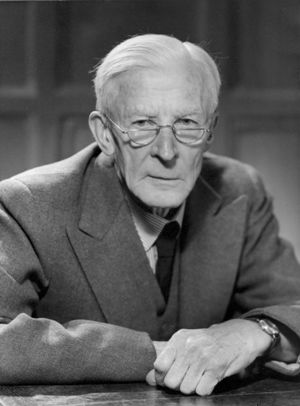Edgar Douglas Adrian, PRS, OM
 1890-1977. Master, Chancellor; Physiologist; President of the Royal Society; winner of the Nobel Prize for his work on nerve impulses.
1890-1977. Master, Chancellor; Physiologist; President of the Royal Society; winner of the Nobel Prize for his work on nerve impulses.
Edgar Adrian went to Westminster School before studying Natural Sciences and then Medicine at Trinity. His wartime clinical work was at St Bartholomew's Hospital in London, where he treated soldiers with nerve damage and nervous disorders such as shell shock. Adrian returned to Cambridge in 1919 and in 1925 began his studies of nerve impulses in the human sensory organs.
Continuing earlier studies of Keith Lucas, he used a capillary electrometer and cathode ray tube to amplify the signals produced by the nervous system and was able to record the electrical discharge of single nerve fibres under physical stimulus. An accidental discovery by Adrian in 1928 proved the presence of electricity within nerve cells.
A key result, published in 1928, stated that the excitation of the skin under constant stimulus is initially strong but gradually decreases over time, whereas the sensory impulses passing along the nerves from the point of contact are constant in strength, yet are reduced in frequency over time, and the sensation in the brain diminishes as a result.
Extending these results to the study of pain causes by the stimulus of the nervous system, he made discoveries about the reception of such signals in the brain and spatial distribution of the sensory areas of the cerebral cortex in different animals. These conclusions lead to the idea of a sensory map, called the homunculus, in the somatosensory system.
Later, Adrian used the electroencephalogram to study the electrical activity of the brain in humans. His work on the abnormalities of the Berger rhythm paved the way for subsequent investigation in epilepsy and other cerebral pathologies. He spent the last portion of his research career investigating olfaction.
Among the many awards and positions he received during his career were Foulerton Professor (1929-1937); Professor of Physiology at Cambridge (1937-1951); President of the Royal Society (1950-1955); Master of Trinity (1951-1965); President of the Royal Society of Medicine (1960-1962); Chancellor of the University of Cambridge (1967-1975); and Chancellor of the University of Leicester (1957-1971). Adrian was elected a Foreign Honorary Member of the American Academy of Arts and Sciences in 1938. In 1942 he was awarded membership to the Order of Merit, and in 1955 was created Baron Adrian of Cambridge.
| Memorial inscription | Translation |
|
EDGAR DOUGLAS ADRIAN BARO DE CANTABRIGIA O.M. HVIVS COLLEGII DISCIPVLVS SOCIVS MAGISTER IN ACADEMIA PHYSIOLOGIAE PROFESSOR ET POSTEA CANCELLARIVS PRIMVS SENSVVM SIGNA AD CEREBRVM MISSA NECNON IVSSA ILLINC REDDITA AVDIIT IDEM INTIMOS IPSIVS CEREBRI SVSVRROS EXCEPIT VIR TAM MODESTVS QVAM ILLVSTRIS ORATOR AVTEM SALSVS AC LEPIDVS TOTIVS SOCIETATIS AMOREM SIBI CONCILIAVIT
|
Edgar Douglas, Lord Adrian of Cambridge, O.M., was Scholar, Fellow and Master of the College, Professor of Physiology and later Chancellor of the University. It was he who first heard the signals that in sensation and movement pass to and from the brain, and he caught whispers of its innermost workings. A man as modest as he was illustrious, and a witty and charming speaker, he won the affection of the whole Fellowship. He died in 1977 at the age of eighty-seven. |
Edgar Douglas, Lord AdrianBrass located on the north wall of the Ante-Chapel. |
Click on the thumbnail for a larger image. |
|
|
PREVIOUS BRASS |
|
NEXT BRASS |
| Brasses A-B | Brasses C-G | Brasses H-K | Brasses L-P | Brasses R-S | Brasses T-W |

